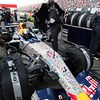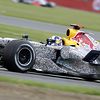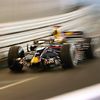RB3, the car

The Red Bull Racing Team unveiled its 2007 Formula One challenger at the Circuit de Catalunya, Barcelona, today. With Adrian Newey on board, the team choose for a total different approach on designing the RB3.
The design process has been led by Red Bull Technology’s Chief Technical Officer, Adrian Newey, who looks back over the months leading up to launch. “One example that illustrates how much more complicated F1 cars have become over the last decade is shown by the fact that I joined McLaren in 1997 on 1 August and we had a brand new car out in February 1998. In contrast, I joined Red Bull in January 2006 and we are only just getting the new car out on time in 2007. This reflects the greater level of research that now goes on in F1 compared to nine or ten years ago. With RB3, we didn’t get the model of the car into the wind tunnel until June 2006, which was a lot later than we would really have wanted. That made for a very busy time prior to hitting the key release dates for fundamentals like the monocoque and the gearbox. This had nothing to do with the uncertainty over what engine we were going to run this year. In terms of engine choice, most of the current V8s are broadly similar in terms of installation, so there isn’t a big difference in design philosophy depending on which engine you choose. The timing was influenced by the fact that what the team is trying to do for 2007 is a bit different to what’s been done in the past. That brought with it its own lead times, also influenced by the need to commission a new wind tunnel in Bedford. All the development of the new car has been done at the Bedford facility, but its commissioning was only completed as we began with the new car. We ran the old car in Bedford just to do a systems check on the tunnel immediately prior to putting the new car model in.”
On the subject of the wind tunnel, Technical Director Mark Smith added: “The Bedford Wind Tunnel might not be the most up to date facility when viewed from the outside as you come up the driveway! But, as an engineering tool, it’s definitely a good piece of kit and something that our Head of Aerodynamics, Ben Agathangelou, has put a great deal of effort into over the last three years. The result is something we can be happy with in terms of its productivity, accuracy and the results it has produced.”
Meanwhile, focusing back on the RB3, Newey explained the concept. “The car will run to a set of regulations, which are now in their third year as, surprisingly, the change from V10 to V8 did not have a fundamental effect on the packaging of the cars. As far as the aerodynamic regulations are concerned, the last big change came ahead of the 2005 season. As such, the car is an evolution of ideas that have been seen before, but aggressively packaged in a car that we hope will have a lot of development potential. Another factor to bear in mind is that, in common with all the other teams that ran Michelin tyres in 2006, we have to design a car that will run on Bridgestone tyres that we are not yet familiar with. Of course we’ve done our research, but we’ve also designed a bit of flexibility in the car to deal with this. Undoubtedly some aspects of RB3 are ‘McLarenesque’ and are, to some extent, a development of the work I was doing when I was there. In other areas, there are derivatives of what has been done here at Red Bull and, of course, there are some completely fresh ideas. The design cycle has been very compressed which has brought its own pressures on both the engineers and the shop floor, but the response by everybody to that pressure has been truly extraordinary and one which we should be very proud of.”
Car designers are supposed to be notoriously dismissive of the unit that powers their creation, regarding the internal combustion engine as a handy spacer between chassis and gearbox, but Newey is enthusiastic about renewing his relationship with Renault. “There are a surprisingly large number of familiar faces from the last time we were together! It’s great to be back working with Renault. I was always very impressed with their methodology back in the Williams days. They are very good and very pragmatic and can get the best out of a package. Past experience has also shown me they are completely professional when supplying two teams. Their reason for supplying a second team is not for financial gain, but rather to have more units out in the field to learn from in both the performance and reliability areas, which gives a fundamentally different cornerstone to the relationship.”
“Maybe I’m an eternal optimist, but I expect to see us make a good step forward,” reckons Mark Smith. “As an absolute minimum I believe we will reach the target area we have set ourselves. Technically I am looking forward to seeing how the car runs, because there are several different design philosophies in Formula One and Adrian has a different philosophy to the one I witnessed in my previous four or five years at Renault, so it will be interesting to see how that pans out. Although all the cars on the grid are quite similar, the way subtleties, such as aero performance, stiffness and mass, are traded off against one another at the design and concept stage can make a big difference when the car hits the track.”
Source Red Bull






